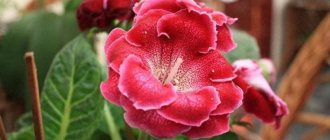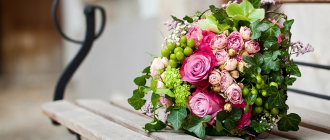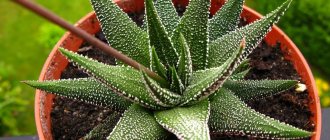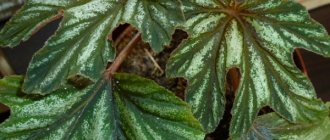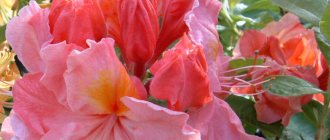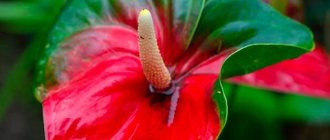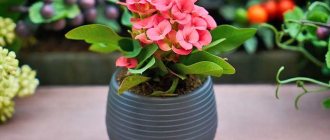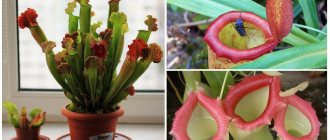Description of the plant
Cordilina is a representative of the Asparagus family. In nature, it is found in all regions with subtropical and tropical climates.
This is a tree or shrub with thick and strong roots and lanceolate, sword-shaped or linear leaf blades.
Attention! At home, cordyline grows extremely slowly.
The annual growth is 10-15 cm. In height, as a rule, the plant does not exceed 1.5 m. With age, the lower leaves of the shrub die and fall off, as a result of which the plant becomes similar to a palm tree. Flower growers value cordilina for its spectacular foliage and unpretentiousness.
Getting to know Anthurium
The flower belongs to the Anthurium genus, of which there are more than 1000 species in nature. Anthurium is an evergreen plant. Grows on trees, has aerial roots. The plant blooms at home all year round (in good light, of course). A flower on Anthurium can last for about 2 months. South America is considered the birthplace of the plant. Anthurium grows in South American and tropical forests. The optimal temperature is about 10 degrees. The air should be humid: from 70 to 90%. The plant in nature develops under the forest canopy and is not exposed to direct sunlight.
How does it bloom?
Flowering of the plant occurs only in nature, at the age of 8-11 years.
When grown at home, it is almost impossible to admire the extraordinary flowers of this beauty. If this happens, it will be no more often than once every three years.
Cordyline blooms with small white, cream, red or purple flowers, collected in dense paniculate inflorescences reaching a length of up to 1 m.
Varieties of codiaum (croton) in the photo
There are many varieties of codiaum on sale, differing in the variety of colors, petal shapes and stem heights.
Aucubofolia - The yellow pattern on the green leaves resembles the coloring of Aucuba leaves.
Baron J. de Rotschild - leaves of different ages change color from olive green to pink and orange. As you can see in the photo of the croton, the veins on all the leaves of this variety of codiaum are emphasized in red.
Batic - the leaves seem to be painted using the batik technique.
Bravo - green leaves with yellow spots.
Norma - the main background of the leaf is green with yellow spots and red veins.
Gold Finger - the leaves are long, narrow, green, with a yellow stripe running along the central vein.
Mrs Iceton - the leaves are large, elliptical in shape, young leaf blades are yellow-green, and more “adult” ones are red-orange with a transition to dark green.
Spiral - red and green leaves are twisted in a spiral.
Yellow Snow - yellow spots on a green background, reminiscent of snow flakes.
There are varieties of codiaum, photos of which are presented in our photo gallery, with less artistic coloring of the leaves. However, this is offset by their intricate shape.
Golden Bell - leaves with constrictions.
Mammie - leaf blades are strongly twisted.
Mascarena - the leaves are straight, narrow, but hang down, and not directed upward like other varieties of codiaum.
Сraigii and Нoluffiana are varieties with lobed leaves.
In interior decoration, the plant can be used both as a tapeworm and in flower arrangements.
Varieties and species with names and photos
The plant unites about 20 different species, differing in size, shape and color of the leaf plate. The following are especially popular.
Straight variety
The most unpretentious look . It reaches a height of 3 m.
It has linear or lanceolate leaf blades with slightly serrated edges, colored green or purple. Leaf length is 60 cm, width - 3 cm. It is distinguished by a high, straight stem, covered below with the remains of dying leaves.
Feels comfortable in cool rooms.
Red
Palm lily or Cordyline rubra is a valuable ornamental plant. Can grow up to 4 m.
It has leathery, slightly concave, lanceolate leaves that are dark green with a reddish tint. Leaf length 50 cm, width 4.5 cm. Blooms in summer with lilac flowers. It does not require special care.
Apical
The most popular species for home cultivation. It has a straight thin trunk, which can sometimes be slightly branched. It reaches a height of 2 m.
It has green lanceolate leaf blades with a crimson, red, pale pink border or stripes.
When kept indoors, it remains compact for a long time and does not have a trunk.
Sheet length 50 cm, width 10 cm.
Fruticosis
A plant with one or several thin trunks up to 1.5 cm in diameter. The leaves are lanceolate, veined, 50 cm long and 10 cm wide.
The length of the petiole is 15 cm. In nature it has a green or variegated color with a purple tint. Blooms with loose cream panicles .
Mix
This is not the name given to a specific variety, but to species and varieties of Cordyline collected on one pallet under one name, denoting mixing.
Australis
Incredibly spectacular, yet undemanding, the plant is especially loved by gardeners.
It has rich green or striped narrow leaves up to 3 cm wide and compact attractive bushes. Outwardly it resembles a dracaena .
Mambo with scarlet or purple leaves
The plant has a thin trunk and an unusual color range of leaf blades, which can be rich green, scarlet, bright red, burgundy or purple. At home, the height does not exceed 1.5 m.
With proper care, it can delight you with gorgeous white or red-purple flowers.
Also called king tree.
Southern dracaena
The tallest type . In its natural environment it grows up to 12 m.
It has a rigid, widening trunk and sword-shaped leathery green leaves with a wide central vein of light color. It blooms with white flowers with a pleasant aroma, collected in meter-long panicle inflorescences. Sheet length 90 cm, width 7 cm.
Terminalis
It is distinguished by large lanceolate leaves of various shades: from soft pink and green to brown or burgundy. In nature it grows up to 3 m in height.
It has erect stems, which become bare in the lower part over time, while maintaining an attractive appearance.
Tango
A variety of cordyline apex.
They are small and neat trees with lush tufts of leaves of a non-trivial brown color with white veins and scarlet edging. Moreover, with age, the plant does not lose the splendor of the rosette and its beauty.
Botanical description
Hippeastrum (lat. Hippeástrum) has long leaves, the width of which can reach 7 cm. The plant’s bulb is large - up to 10 centimeters in diameter.
The height of the peduncle arrow can exceed 1 m. It contains large buds. Depending on the variety, their diameter can reach up to 20 cm. The number of flowers varies from 2 to 10 pieces. They can be of different colors and shades - from white to dark red.
Colors with dots, spots of a different color, with a transition of shades from the funnel to the edge of the bud are common.
Benefits, harms and properties
According to superstitions, cordilina has a positive effect on creativity and, being a true peacemaker, maintains a warm atmosphere in the house, helps restore the aura, neutralizes quarrels and suppresses gossip.
It is recommended to keep Cordilina in houses where strangers often come : thanks to her, the owners will never feel tired and empty after the guests leave.
In the teachings of Feng Shui, cordilina combines the energy of wood and fire. By placing it in the corner of the room, you can activate the Chi energy. In addition, the plant belongs to the Yang type and is not recommended for placement near working and sleeping places. The optimal part of the house for cordilina is the south or east side.
Pruning a domestic palm tree
Removing weak and diseased shoots contributes to the rejuvenation and formation of the plant . Thanks to pruning, the lateral buds begin to grow, and the cordyline creates a dense leafy crown.
You should take a sharp and clean knife and trim the top of the bush. It is important that the cut part is no shorter than 6 cm, has leaves and is woody. Then the cut areas must be sprinkled with coal powder. After 14-20 days, fresh shoots will appear at the cutting sites.
The cut top can be rooted in water or a damp mixture of peat and sand, and after the roots appear, plant it in a small pot.
Home care
In order for indoor plants to be healthy and grow well, it is enough to follow a number of simple care rules. Spathiphyllum does not like being exposed to direct sunlight. The optimal location for it is considered to be a shady place or artificial lighting. Since the plant prefers air with high humidity, it needs to be watered moderately and the leaves well sprayed from above. In the tray of the container with spathiphyllum, water should not stagnate for longer than 1.5 hours.
In spring, the plant should be transplanted into a larger pot.
The choice of pots is carried out on the basis that the roots of the flower should be located comfortably in it. They need room to grow. However, the container should not be too loose in volume.
Watering mode: winter - summer
In summer and spring, spathiphyllum loves abundant watering. After all, at this time the plant blooms. However, you should make sure that the soil dries out between waterings: waterlogging should not be allowed. At least this applies to the outer layer of the earth. In winter and autumn, watering is moderate. At this time, the plant can stand longer without watering, but you must always be on guard. If you water the plant abundantly in winter and keep it on a cold windowsill, then problems with the root system are guaranteed.
Lighting requirements
It is better if diffused light falls on the spathiphyllum. Although the plant likes well-lit areas, hot sunlight can damage the leaves. Therefore, you can place the flower in a slight shade without direct sunlight. In summer, shading the plant is a must.
Temperature
The average temperature for spathiphyllum is +16-17 °C. It can withstand temperatures down to +13 °C, but this will stop the development of the plant. In summer and spring, spathiphyllum prefers a temperature of +22-23 °C. However, it can withstand heat of +27 °C provided it is watered abundantly.
Air humidity
Air humidity can be high: spraying at any time will be useful. It is recommended to plant the plant in a pot with a tray into which water should be poured. The moisture will evaporate, creating a special microclimate.
Fertilizer, top dressing
In spring you need to feed the plant with mineral fertilizers. The fertilizer concentration is as follows: 1.5 grams per liter of water. In summer and during flowering, you can also feed with minerals. When the plant has not yet grown, fertilizers should be applied once every two weeks. Then you can feed once a month. Substances of organic origin, such as diluted bird droppings, are also good as fertilizer. In winter, fertilizing is usually less frequent and in smaller doses.
To better allow air and water into the soil, you need to add a little charcoal or crushed polystyrene foam or small pieces of broken bricks to the mixture. The amount of any material should be no more than 15% of the total volume of the mixture.
Propagation by seeds
Help : with the seed propagation method, the varietal characteristics of the parent plants are lost, so it is suitable only for species plants.
Seeds are sown in early March in turf soil mixed with sand. They sprout unevenly and germinate for quite a long time, within 1-3 months, but the grown trees are fully adapted to home conditions.
Now you have the necessary information about this chic and unpretentious plant that can decorate your home or office and create a peaceful atmosphere in it. All that remains is to choose the type of cordyline that is most attractive to you.
